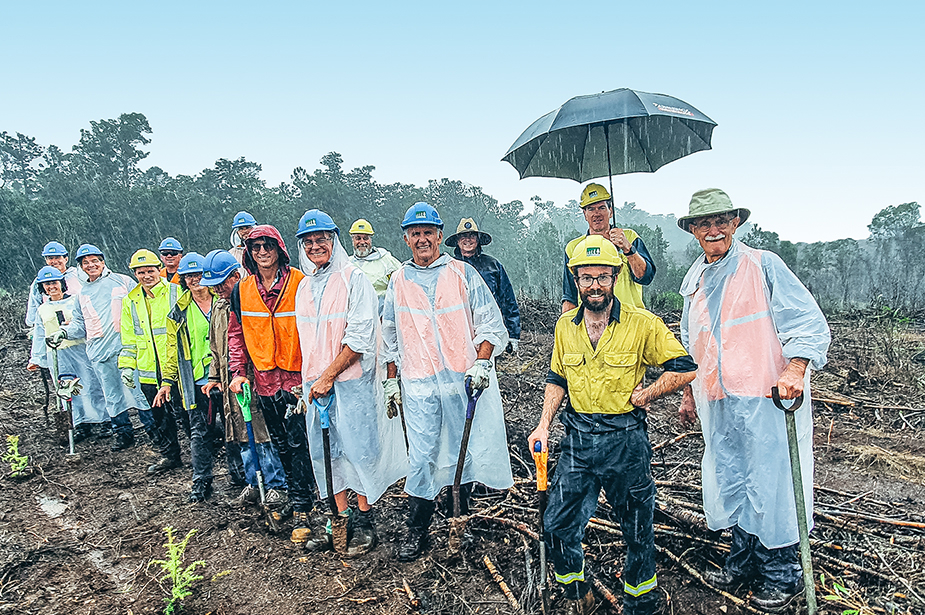Jimna recovery after the fire

A wide range of people in the forestry industry attended, including the CEO of Timber Queensland Mick Stevens, private forest growers, students, a DES representative, and forestry and fire consultants. The theme was Hoop Pine (Araucaria cunninghamii) Plantation Management and Recovery from the 2019 Fire Season.
Andrew Dunn, Dan O’Regan, Lester Jarick and Brendan Foster presented information on the Jimna fire, the salvage harvest operations and progress on the re-establishment of the plantation.
Over a year on from the Black Summer fires, it was interesting for the HQP staff as well as the visitors to reflect on the conditions we experienced then and how far we have come on the journey to recovery.
On 8 November 2019 in Jimna the weather conditions were:
- Temperature: up to 39°C
- Windspeed: 15km/h gusting to 35 km/h
- FFDI: up to 48 (Very High)
- FFDI at 10 m: up to 58 (Severe)
- KBDI: 149
In these difficult conditions, a small fire burning to the west of Jimna township, which had been contained and was being actively patrolled by HQPlantations staff, took off. In a matter of minutes, the fire crowned in dry sclerophyll vegetation, jumped the main Kilcoy-Murgon Road and continued through dry rainforest, Araucaria and hardwood plantations, running for three days until it was fully contained. The dry rainforest vegetation, which typically doesn’t burn, seemed to explode in the conditions that week, spotting up to 1km in advance of the main fire front.
HQPlantations mobilised all available resources for the extended campaign: day shifts typically consisted of 10-15 mop up units, 1 tanker, 5 dozers, 1 grader and 2 helicopter water bombers. The township of Jimna and a local campsite were temporarily evacuated. HQPlantations resources were drawn from across the business including local Inland crews, Coastal, Central and North Queensland as well as staff from North Lakes and 20 firefighters from HVP Plantations in Victoria. QFES personnel assisted with the protection of the township and QPWS with the operations in the field. In addition to the Jimna fire, there were several other fires being attended to across SE QLD. In spite of everyone’s best efforts and in excess of $1 million spent, 658 ha of Araucaria plantation and 904 ha of native vegetation were affected. To the credit of everyone involved, there were no serious safety incidents.
A salvage harvesting operation began as soon as possible on 15 November, while the fire was still being mopped up, and managed to extract 60,000 tonnes of Araucaria of various age classes from 260 ha over seven months. After that, insect and blue stain damage caused the timber to degrade to a point where it was no longer suitable for processing. Of the total harvested volume, 36,000t was delivered to local ply and sawmills and 24,000t was exported.
Replanting also got underway as soon as possible once rains returned, with 40 ha planted straight into the burned ground. Various techniques have been employed since then to re-establish another 230 ha of Araucaria plantation on areas that still contain some standing burned trees, on flat to very steep terrain. Despite multiple constraints to the planting program (soil moisture, machinery availability, seedling availability and availability of labour), the re-planting is expected to be complete by 2023.
To assist in a small way with the replanting effort and to celebrate the recovery of the plantation on the International Day of Forests, the field trippers ended the day by planting 100 trees. The rain that had been ordered to water in the seedlings came a little early unfortunately, so the planting crew got a bit wet, but it didn’t dampen spirits! There was great enthusiasm all round for the tree planting and providing timber for future generations of Queenslanders.
